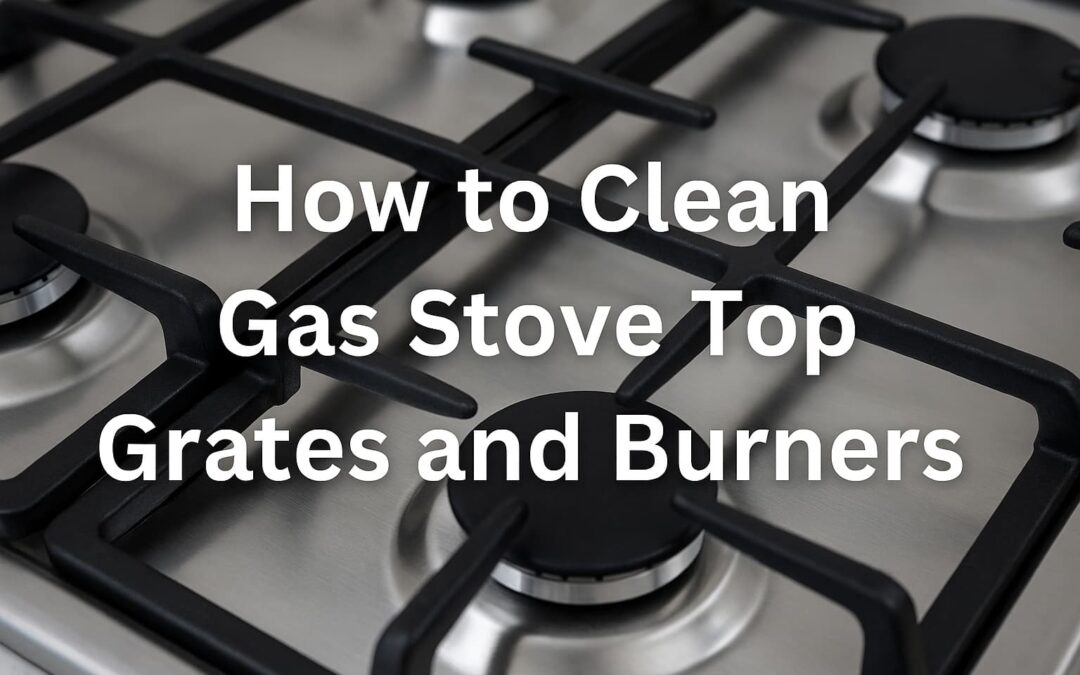Gas stoves are reliable, powerful, and beloved by home cooks — but keeping them clean can be a challenge. Food spills, grease splatters, and burnt-on residue quickly build up on grates and burners. If left too long, they not only look bad but also affect cooking performance and safety.
The good news? With the right methods, you can deep-clean grates and burners without damaging them. This guide walks you through daily care, deep cleaning, and tips to keep your gas stove running like new.
Key Takeaways
- Always let grates and burners cool completely before cleaning.
- Soak grates in hot, soapy water to loosen grease.
- Use baking soda paste or vinegar spray for burnt-on food.
- For burners, clean with a soft brush — avoid harsh scrubbing or poking gas ports.
- Regular cleaning improves cooking efficiency and prevents clogs.
Why Do Gas Stove Grates and Burners Need Special Care?
Unlike flat cooktops, gas stoves have removable grates and open burners. They’re exposed to direct heat, grease, and food spills. Over time, buildup can:
- Block gas flow, leading to uneven flames.
- Create unpleasant odors when reheated.
- Cause scratches or rust if cleaned improperly.
Routine cleaning ensures both safety and efficiency.
How Do You Clean Gas Stove Grates?
Step-by-Step Method
- Cool completely before removing.
- Remove grates and place in sink.
- Soak in hot water + dish soap for 15–20 minutes.
- Scrub gently with a non-abrasive brush or sponge.
- For stubborn grease → apply baking soda paste (baking soda + water), let sit 15 minutes, then scrub.
- Rinse and dry thoroughly to prevent rust.
👉 Pro Tip: For heavy grease, place grates in a zip bag with ¼ cup ammonia overnight. Rinse well next day.
How Do You Clean Gas Stove Burners?
Burners are more delicate than grates because they control gas flow.
Steps for Burner Caps & Heads
- Remove burner caps and heads (check manual if unsure).
- Wash in warm, soapy water with a sponge.
- Use a soft toothbrush to scrub crevices.
- For burnt-on food, use baking soda paste or vinegar soak.
- Rinse thoroughly and dry before reassembling.
Cleaning Burner Ports (Where Flame Comes Out)
- Use a straightened paperclip or pin to gently clear clogged holes.
- Avoid toothpicks — they can break off inside.
- Never use harsh force — ports can bend or crack.
Natural Cleaners for Grates and Burners
- Baking Soda Paste → Removes stubborn grease.
- Vinegar Spray → Cuts through oil and deodorizes.
- Lemon Juice + Salt → Works on rust spots.
- Hydrogen Peroxide + Baking Soda → For extreme burnt-on residue.
💡 Avoid bleach or harsh chemicals that may corrode metal.
What Tools Are Safe for Cleaning Gas Stove Parts?
| Tool | Safe/Unsafe | Notes |
|---|---|---|
| Nylon brush | ✅ Safe | Gentle scrubbing for grease |
| Microfiber cloth | ✅ Safe | Good for drying and polishing |
| Toothbrush | ✅ Safe | Perfect for burner crevices |
| Steel wool | ❌ Unsafe | Scratches enamel coating |
| Harsh scouring pads | ❌ Unsafe | Can damage grates & burners |
How Often Should You Clean Grates and Burners?
- Daily: Wipe spills as soon as the stove cools.
- Weekly: Wash grates and burner caps in warm, soapy water.
- Monthly: Deep clean with baking soda paste or vinegar soak.
- As Needed: Clear burner ports if flame is uneven or yellow.
Common Mistakes to Avoid
- Cleaning while still hot → risks burns and cracks.
- Using harsh abrasives → scratches enamel or metal.
- Forgetting to dry → leads to rust.
- Spraying water directly into burner ports → clogs gas flow.
FAQs
Can I put gas stove grates in the dishwasher?
Yes, if manufacturer allows. But repeated cycles may dull enamel finish.
Why is my gas burner flame yellow instead of blue?
Usually a clogged port. Clean gently with a pin.
Can vinegar damage stove grates?
No, vinegar is safe for enamel-coated and cast-iron grates when rinsed well.
How do I remove rust from grates?
Scrub with baking soda + lemon juice paste, rinse, and dry thoroughly.
Quick Gas Stove Cleaning Checklist
- Remove and soak grates weekly.
- Scrub with baking soda paste for burnt food.
- Wash burner caps and heads in soapy water.
- Clear burner ports with pin if flame is uneven.
- Dry completely before reassembling.
Final Thoughts
Gas stoves make cooking faster and more precise, but they demand proper care. Cleaning grates and burners regularly prevents buildup, improves cooking efficiency, and keeps your kitchen safe. With simple tools like baking soda, vinegar, and a soft brush, you can restore your stove to like-new condition without scratches or damage.
A little weekly effort goes a long way — your gas stove will thank you with stronger, steadier flames for years.

As the chief content writer, Hassan Al Sarker works as a professional kitchen-based content creator at Kitchen Liker.
In addition to reviewing the content published on Kitchen Liker, he ensures that it is accurate, relevant, and helpful. As a result, all the reviews and information published at Kitchen Liker are neutral and userfriendly.
Hassan Al Sarker has a bachelor’s degree in Hotel and Tourism Management From the Newyork University. Before joining Kitchen Liker, he was a contributor at Kitchen Club, United States.

